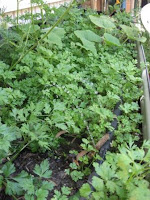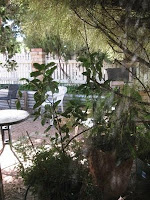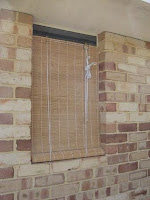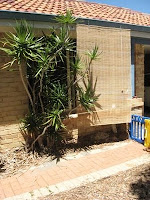I started writing this post in May, and just found it now in my saved drafts. Oops! I have updated and completed it, and here it is. Now titled '18 months on...' but initially '12 months on, as reflected in the intro.
-----------------
Twelve months on feels like time to check how things are going. Did we keep up our commitments? How have they worked out for us? Are we going on with the project?
Weather sealing the front door - Yep, less drafty. My only comment is that it makes the door a bit harder to shut - if its not locked it sometimes swings back open.
Pipe insulation - It would be good to insulate the rest of the pipes but they appear to be unreachable. The insulation doesn't seem to be sustaining weather damage or coming away from the pipes.
Laundry & Dishwasher Powder - Right after we agreed to do this I accidentally bought a whole lot of regular laundry powder super cheap, and we had only recently purchased regular dishwasher powder, so we took a couple of months to work our way through that. The eco-friendly stuff seems to give an equally good clean.We buy either Earthchoice or Aware laundry powder and it is on special often enough that I don't have to pay the shelf price as quoted in my initial blog very often.
Hot Water Temperature - Cold weather came and went and our showers were still plenty warm enough in the morning.
Getting rid of 'standby' - It took a little while to get into the habit of switching the whole system off, but now it is second nature. The only drawback is that if we want to leave one thing plugged in, like a mobile phone charging overnight or a fan to speed up drying nappies in rainy weather, we have to leave the whole computer system on standby as there is only one power outlet in the office.
Shade Cloth on east wall - We considered rolling it up for winter, as the office got very cold even during the day, but there is no direct sun on that wall in winter anyway, so we didn't bother. We wore ugg-boots and jumpers, wrapped blankets round our legs (well, I did - Tyson I think sees that as too much like a granny thing) and referred to the office as 'the icebox' for a couple of months. I seem to recall it was pretty cold in there the previous year too, so I'm not sure it was because of the shade cloth. Now its summer again and shade cloth is my friend.
Grey Water - All summer we carted buckets of water from the washing machine and showers to keep the garden alive. We didn't turn on a hose for the garden at all! When the rain started I didn't know what to do. It felt so wasteful to let the water go down the drain, but the garden didn't need it. We used the shower buckets to flush the toilet again for winter, but the washing machine had to just drain away. This summer we have enough water for the garden from showers and Eva's bath, as she is in the big bath now. Also, the buckets from the washing machine got quite grimey with soap scum and I haven't been that keen to return to using laundry water if we don't need to. Perhaps in the hottest months we will do it again. Tyson captured some laundry water last week when he needed to do five loads of washing in one day.

Irrigation - The system has been revamped for the new garden and works better than ever. As an added bonus, Eva loves the routine of carrying buckets outside and watching the water come around the garden. She has dug herself a lake under two spouters and watches it fill up and drain away every morning.
Compost - Our tubs weren't working so well, and we got rats (which ATE OUR PUMPKINS!!! I can't tell you how cross I was, especially as I saw the last one get taken in front of me). Next we tried a pile in the garden, wrapped in plastic and hemmed in by bricks. We still got mice. Eventually we bought a compost tumbler. Tyson wanted one with a handle that goes round and round rather than end over end, but they are ludicrously expensive (about $800!!) and his friend who runs a hardware store assured him they rust out quickly. End-over-end can get quite heavy and awkward to turn, but so far not unmanageable. The only flaw in the system now is that we tend to be lazy about taking the scraps outside, and once the inside bucket is full I think organic matter does end up in the regular bin sometimes.
Cloth Nappies - We are still using cloth. In the past year we have used about two packs of disposables (total 60 nappies?) plus a few disposable swimmer nappies. The system of cloth wipes only lasted about 6 months, though. I always felt like I was spilling water around the place, and the cloths seemed kind of scratchy for a little bum. At first I meant to replace them with softer fabric, but now I have admitted to myself that I am never going to do that, as disposable wipes are too convenient. But the cloth nappies... I am happy to recommend the brand we use (see original post) as we have had only one wet bed (and that was our fault for not getting the nappy cover on properly) and a handful of leaks of any kind.We had to buy more covers a few months back as the first lot were getting a bit small and their elastic was wearing out, and we will have to buy another round of covers before Eva is through with nappies, but the nappies themselves are lasting brilliantly.
Lighting - Still in place. No globes have needed replacement yet. I forget they are anything but plain ordinary globes.
The Conversation -Its been a while since we revisited our commitment to living sustainably. But then, I think it has become embedded in our lifestyle, which was initially our hope in taking up the monthly challenge. We still like the idea but have trouble finding time to implement it every month. Its an ongoing but sporadic conversation now.
















